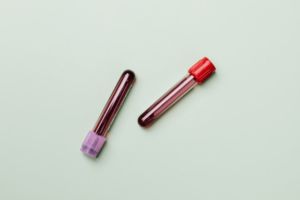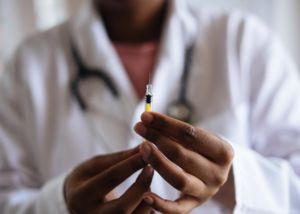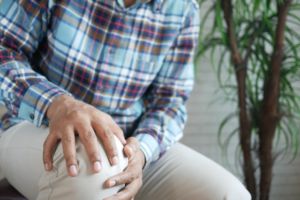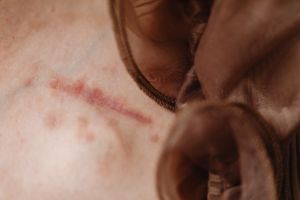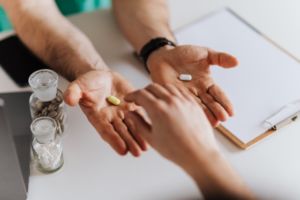
Over 20% of Americans suffer from some sort of chronic pain. There are many underlying causes of chronic pain. Many people struggle with pain caused by soft tissue or joint damage that refuses to heal completely. Chronic low back pain is the leading cause of disability in the U.S. Stubborn back pain can be caused by spinal disc injuries, arthritis, or soft tissue injury. Platelet-rich plasma injections or PRP is effective for many of these causes of chronic pain.

The Stalled Healing Cycle (A Major Cause of Chronic Pain)
The healing cycle has three main stages: Inflammation, proliferation, and remodeling. All these stages rely on specialized cells brought to the injured area by blood flow. Some cells clean the injured area and stop bleeding, while others produce collagen and engineer new tissue. A wounded area has to move through every part of the healing cycle to have strong tissue that won’t be quickly reinjured. Once the healing process is complete, inflammation should return to pre-injury levels.
A stalled healing cycle is often responsible for chronic pain and inflammation. In some cases, the injured area doesn’t receive enough blood flow to heal. It stays stuck in the first stage of healing, the inflammations stage. It may create some new tissue but not organize it properly, leading to excess scar tissue or tender tissue. The result is chronic pain, stiffness, and loss of range of motion.
Stalled healing often happens in joints, tendon and ligament injuries, and disc injuries. None of these structures receive robust blood flow and therefore struggle to heal. Since these areas move often, the pain can be debilitating and difficult to treat.
What is PRP?
PRP is made from the patient’s blood. Your provider will collect a sample through a routine blood draw and then use a centrifuge machine to separate the red blood cells from the platelets and plasma (the liquid part of the blood). They will then combine the platelets with the plasma and inject it into the injured area.
PRP contains over 30 bio-active proteins that contribute to tissue growth and healing. When PRP is injected at the injury site, it reduces inflammation, enhances cellular growth, and promotes bone and soft tissue healing. Essentially, PRP activates your body’s natural healing process, but the effect is amplified.
PRP injections are typically given as a set of three over a few weeks. Most patients notice some improvement in their symptoms after the first injection. After all three injections, your symptoms will continue to improve for several weeks as the natural healing process progresses.
Patients with injuries that can heal may not need more shots after the initial three injections. Some patients, especially people with degenerative conditions like arthritis, will need a yearly “booster” to keep their pain under control. PRP does not cure arthritis, but it significantly improves pain and can slow joint degeneration.
How Safe is PRP?
One of the best things about PRP is its safety record. Since no foreign materials are being injected, chances of allergic reactions are almost zero. Your own plasma will not introduce you to any diseases or be rejected by your body. There is a risk of infection anytime the skin barrier is broken, but that risk is very small when a licensed provider performs an injection.
As with all procedures, some people are not good candidates for PRP. Pregnant women, people with bleeding disorders, and people with certain cancers should talk to their doctor before seeking PRP treatment.
What Conditions Can PRP Treat?
PRP can be used to treat a wide range of injuries. Some of the most common problems we treat with PRP include:
- Osteoarthritis
- Lumbar spinal disc pain
- TMJ
- Muscle tears
- Rotator cuff injuries
- Repetitive use injuries
- Lumbar and cervical facet joint dysfunction
- Tendon and ligament injuries
Some of these are repetitive-use type injuries that can impact a person’s ability to work or do daily tasks. PRP can effectively reduce pain and help you get back to your routine. Studies have shown that PRP is especially effective at treating rotator cuff tears and can help some patients avoid surgery.
What About Old Injuries?
Many people with chronic pain have struggled for years. You may have had an acute injury that turned into a chronic issue. The good news is that for most people, it’s never too late to use PRP. Inflammatory enzymes ‘tell’ the PRP where to work. Since chronic pain is often caused by low-level inflammation, the platelets will go to work in that area and restart the failed healing process.
What Makes PRP Different from Other Treatments?
Corticosteroids are commonly used for people dealing with pain and inflammation. Steroids only work for a short time and can cause serious side effects if used long-term. They are better suited to people with acute injuries than to cases of chronic pain. Opioid pain relievers don’t heal the problem; they just mask symptoms and can lead to addiction and other side effects. Muscle relaxants are another commonly prescribed drug for chronic pain patients. This is unfortunate because the FDA has only approved muscle relaxants for short-term use. Studies show that they do not significantly improve pain or healing outcomes for most people with low back pain. Surgery is sometimes an effective treatment, but it comes with many risks. Low back surgeries often fail to fix the problem and leave the patient with the same pain level they had before surgery.
PRP is different because it is one of the safest treatments available with a less than 1% risk of side effects like bleeding or infection. It is not addictive and could help you become less dependent on addictive pain-relieving drugs. PRP heals the underlying problem rather than just masking the symptoms. The results are long-lasting and, in some cases, permanent. We find that patients who have tried other treatments without success often see great results with PRP.
PRP Injections in Houston
At Vanguard Spine & Sport, we specialize in providing cutting-edge, proven treatments to our clients dealing with chronic pain. Healing is possible! Schedule a consultation to find out how you can live pain-free.


